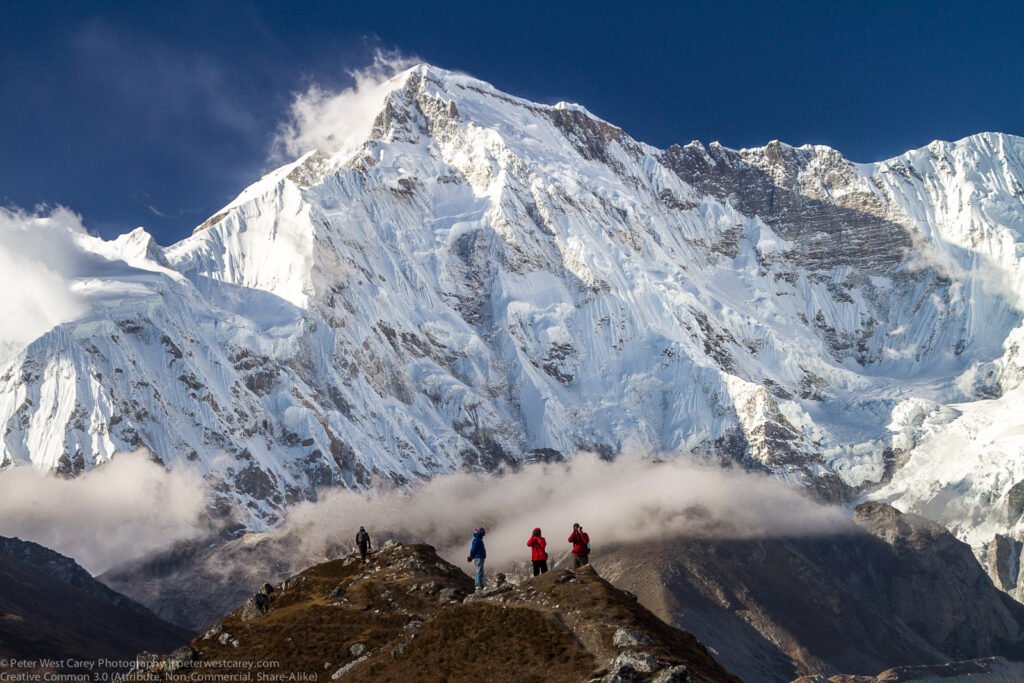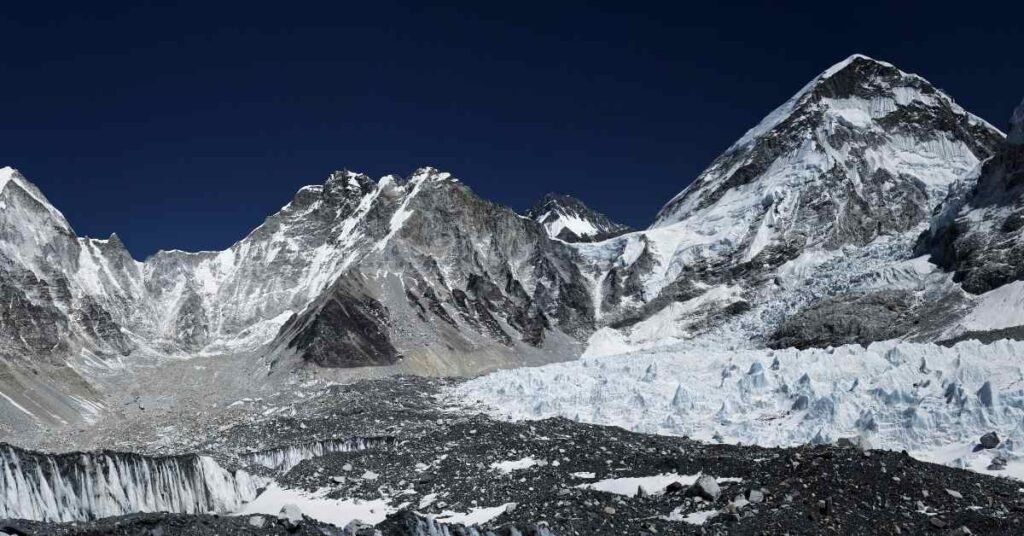01.Overview of Paldor Peak Climbing:
Paldor Peak, standing at 5,896 meters (19,343 feet), is a stunning and challenging climbing destination located in the Ganesh Himal range of Nepal. Known for its relatively accessible height and technical climbing routes, Paldor Peak attracts mountaineers from around the world seeking to experience the thrill of Himalayan climbing without the extreme altitudes of some of Nepal’s highest peaks.
Situated in the remote Ganesh Himal region, Paldor Peak offers breathtaking views of the surrounding landscapes, including other majestic peaks and verdant valleys. The region is named after the Hindu deity Ganesh and is renowned for its picturesque scenery, cultural richness, and diverse flora and fauna. The approach to Paldor Peak typically begins from Syabrubesi, a village that also serves as the gateway to the Langtang Valley.

The most popular routes for ascending Paldor Peak are the North-East Ridge and the South-East Ridge. These routes provide climbers with a variety of challenges, including snow and ice climbing, steep slopes, and technical sections requiring the use of ropes, crampons, and ice axes.
A standard climbing itinerary for Paldor Peak usually spans around 15-20 days. It includes several key stages:
– *Trek to Base Camp: Starting from Syabrubesi, trekkers pass through lush forests, traditional villages, and terraced fields before reaching the base camp at around 4,270 meters (14,009 feet).
– *Acclimatization Days: These are crucial for adjusting to the altitude and preparing for the climb.
– *Summit Push: The final ascent typically takes 2-3 days, with a high camp established at around 5,300 meters (17,388 feet) to position climbers for a pre-dawn summit attempt.
– *Descent and Return: After summiting, climbers descend back to base camp and retrace their steps to Syabrubesi.
02.Optimal Climbing Season:
Choosing the right season for climbing Paldor Peak is crucial to ensure a safe, enjoyable, and successful expedition. The optimal climbing seasons for Paldor Peak are the pre-monsoon (spring) and post-monsoon (autumn) periods. These seasons offer the most favorable weather conditions for mountaineering in the region, providing climbers with more predictable and stable environments.
a.Pre-Monsoon Season (April-May):
*Weather Conditions:
– Temperature: During the pre-monsoon season, temperatures at lower altitudes are mild and comfortable, typically ranging from 10°C to 20°C (50°F to 68°F). As you ascend, temperatures drop significantly, with nighttime temperatures at higher altitudes falling well below freezing.
– Precipitation: This period is characterized by relatively dry weather, with lower chances of heavy rainfall or snowfall. Clear skies and better visibility are common, which are crucial for navigation and enjoying the scenic views.
– Wind: Winds are generally moderate, though high-altitude winds can still be strong and cold. It is essential to check the weather forecast regularly and be prepared for sudden changes.

b.Advantages:
– Snow Conditions: The snow is generally more stable and firm in the spring, reducing the risk of avalanches and making it easier to use crampons and ice axes.
– Longer Days: Longer daylight hours provide more time for climbing and reduce the risk of having to navigate in the dark.
– Flora and Fauna: Springtime brings blossoming flowers and active wildlife, enhancing the natural beauty of the trek to base camp.
c.Post-Monsoon Season (September-November):
*Weather Conditions:
– Temperature: Post-monsoon temperatures are similar to those in the pre-monsoon season, with mild temperatures at lower altitudes and colder conditions at higher elevations. Expect daytime temperatures to range from 10°C to 20°C (50°F to 68°F) at lower levels, dropping significantly higher up.
– Precipitation: The post-monsoon period is marked by clear skies and minimal precipitation. The monsoon rains clear the dust and pollution, resulting in crisp, clear air and excellent visibility.
– Wind: Like the pre-monsoon season, winds are generally moderate but can be strong at higher altitudes. Always be prepared for variable conditions.
*Advantages:
– Clear Skies: The clarity after the monsoon season means spectacular views of the surrounding peaks and landscapes, which is ideal for photography and enjoying the natural beauty.
– Stable Weather: The stable weather patterns reduce the likelihood of unexpected storms, making it safer for climbers.
– Lower Crowds: This season often sees fewer climbers compared to the pre-monsoon season, offering a more peaceful and less crowded climbing experience.
d.Preparation for Seasonal Conditions:
*Clothing and Gear:
– Layering: Due to the significant temperature variations, dressing in layers is essential. Base layers should wick moisture, insulating layers should provide warmth, and outer layers should protect against wind and rain.

– Footwear: Sturdy, insulated, and waterproof boots are necessary to handle the varying terrain and temperatures.
– Technical Equipment: Ensure you have all the necessary climbing gear, including crampons, ice axes, ropes, and harnesses, and that they are suitable for cold-weather conditions.
*Acclimatization:
– Schedule Rest Days: Incorporate rest days into your itinerary to allow your body to adjust to the altitude, especially if climbing in cooler post-monsoon conditions when physical exertion can feel more strenuous.
– Hydration and Nutrition: Staying hydrated and maintaining a balanced diet is vital for coping with the physical demands of high-altitude climbing.
*Health and Safety:
– Monitor Weather Reports: Keep a close eye on weather forecasts and be prepared to adjust your plans if adverse weather is predicted.
– Emergency Plans: Have a clear emergency plan in place, including knowledge of the nearest medical facilities and evacuation procedures.
By selecting the optimal climbing season and preparing accordingly, climbers can maximize their chances of a safe and enjoyable ascent of Paldor Peak, making the most of the favorable weather conditions and breathtaking scenery that these periods offer.
03.Permits and Regulations:
Climbing Paldor Peak requires adherence to several permits and regulations to ensure a smooth and legally compliant expedition. These permits are necessary for both safety and environmental conservation. Here’s a detailed explanation of the required permits and the regulatory framework involved in climbing Paldor Peak:
a.Climbing Permit:
*Nepal Mountaineering Association (NMA):
– NMA Permit: Paldor Peak is classified as a “trekking peak” by the Nepal Mountaineering Association. Climbers must obtain a climbing permit from the NMA. The cost of the permit varies depending on the season and the size of the climbing group.
– Application Process: Permits can be applied for through the NMA’s website or at their office in Kathmandu. It is advisable to secure the permit well in advance of the climb to avoid any last-minute complications.
b.Trekking Permits:
*Trekkers’ Information Management System (TIMS) Card:
– TIMS Card: All trekkers in Nepal are required to carry a TIMS card. This card helps in tracking trekkers in case of emergencies and ensures safety and security. There are two types of TIMS cards: green (for independent trekkers) and blue (for trekkers joining organized groups).
– Where to Obtain: TIMS cards can be obtained from the Nepal Tourism Board offices in Kathmandu and Pokhara or through registered trekking agencies.
*National Park Entry Permit:
– Langtang National Park Permit: If your route to Paldor Peak passes through Langtang National Park, you will need an entry permit for the park. This permit is essential for the conservation of the park’s ecosystem and supporting local infrastructure.
– Cost and Availability: The permit can be purchased at the Nepal Tourism Board office in Kathmandu or at the park’s entry points. Be sure to carry sufficient copies of your passport-sized photographs and your passport.
c.Regulatory Bodies and Compliance:
*Local Regulations:
– Environmental Conservation: Climbers must adhere to strict environmental guidelines to minimize their impact on the fragile mountain ecosystem. This includes proper disposal of waste, avoiding the use of single-use plastics, and following designated trekking and climbing routes.
– Cultural Respect: Respect local customs and traditions. Engage positively with local communities and contribute to sustainable tourism practices by supporting local businesses and services.
*Guidelines from Nepal Mountaineering Association:
– Briefings and Updates: Before embarking on the climb, attend any mandatory briefings organized by the NMA or your trekking agency. These briefings provide crucial updates on weather conditions, route information, and safety protocols.
– Insurance Requirements: Ensure you have comprehensive travel and climbing insurance that covers high-altitude climbing, medical emergencies, and evacuation costs.
d.Importance of Compliance:
*Safety and Rescue Operations:
– Tracking and Assistance: The permits and regulations are designed to ensure the safety of climbers. In case of an emergency, having the proper permits ensures that rescue operations can be conducted efficiently.
– Legal Protection: Possessing the correct permits protects climbers from legal issues with local authorities and ensures that the climb is conducted within the framework of Nepali law.
*Conservation Efforts:
– Supporting Local Communities: The fees collected from permits contribute to the conservation of the natural environment and support local communities through infrastructure development and maintenance.
– Sustainable Tourism: Adhering to regulations promotes sustainable tourism, ensuring that Paldor Peak and its surroundings remain pristine and accessible for future generations of climbers.
By understanding and complying with the necessary permits and regulations, climbers can ensure a legally compliant, safe, and environmentally responsible expedition to Paldor Peak. This preparation not only enhances the individual climbing experience but also contributes to the preservation and sustainability of Nepal’s majestic mountain landscapes.
04.Technical Skills and Training:
Climbing Paldor Peak requires a good level of physical fitness and technical climbing skills. Prior experience with alpine climbing and familiarity with using mountaineering equipment such as crampons, ice axes, and ropes are highly recommended. Comprehensive training and acclimatization are essential to handle the altitude and technical aspects of the climb.
05.Hiring Experienced Guides:
– Hire experienced local guides and porters. Local guides possess invaluable knowledge of the terrain and weather patterns, enhancing the safety and success of your climb. They can also help with navigation and carrying heavy loads, allowing you to conserve energy for the ascent.
